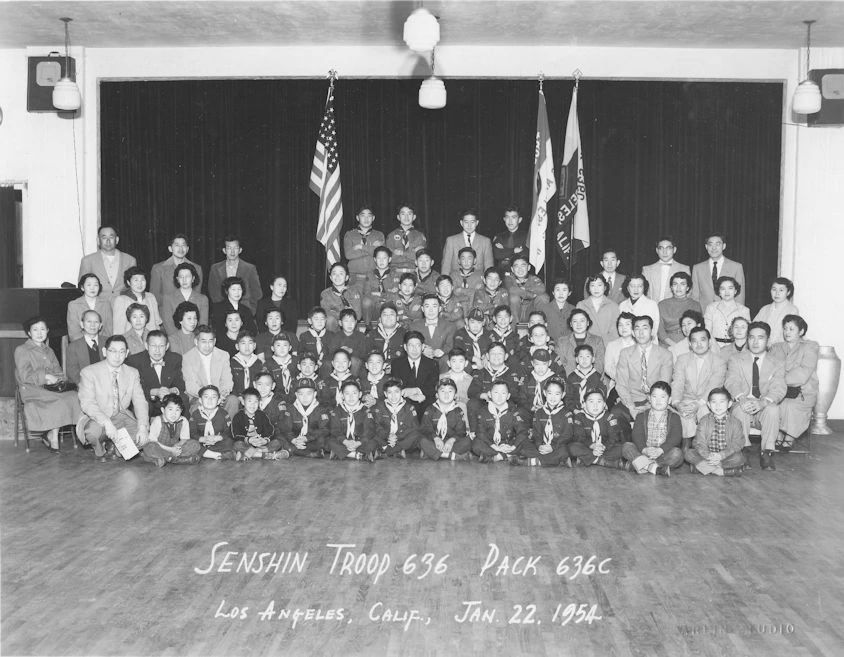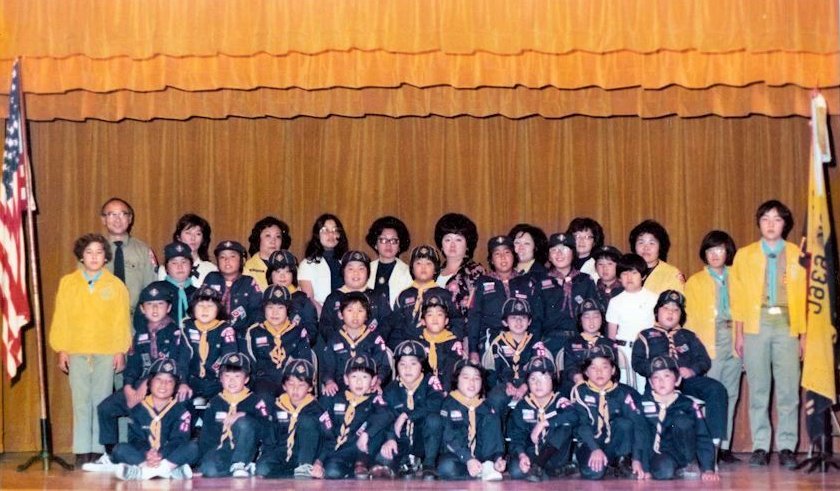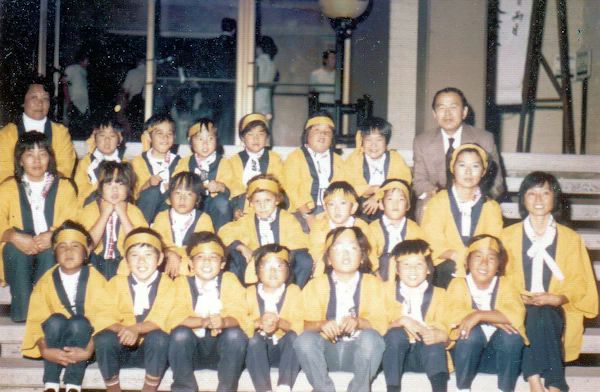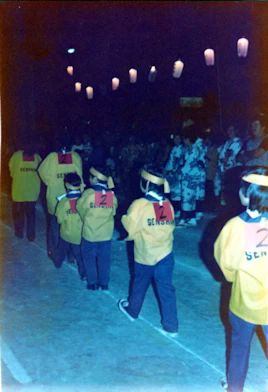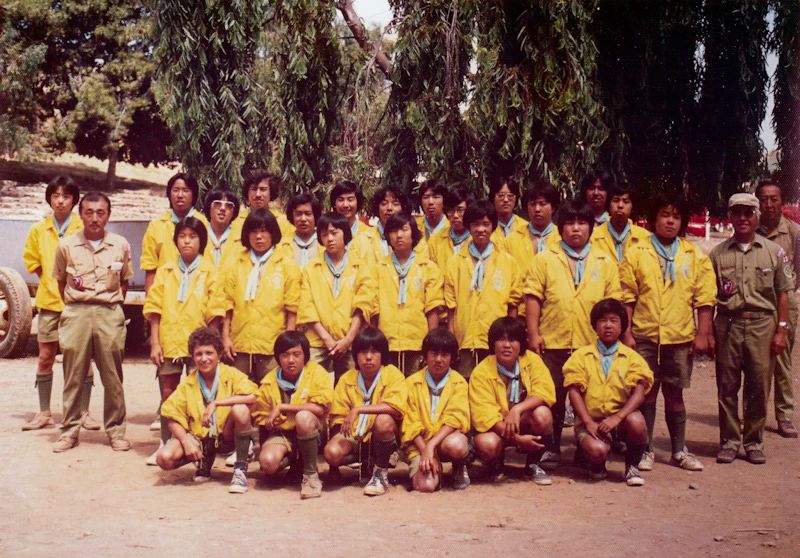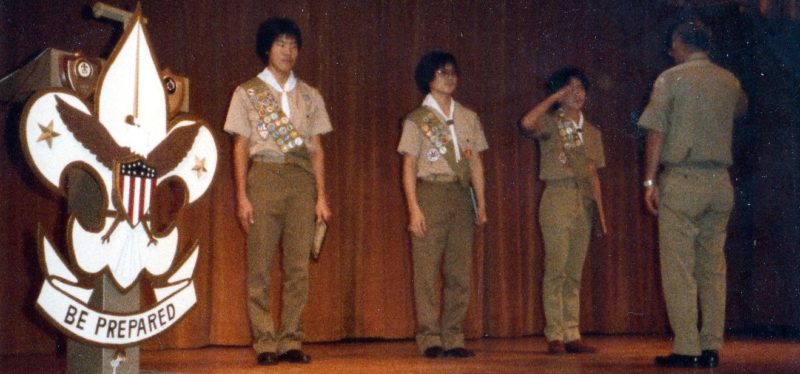History of Senshin Scouting Unit 636
Explorer Post. Boy Scout Troop. Cub Scout Pack
Organization
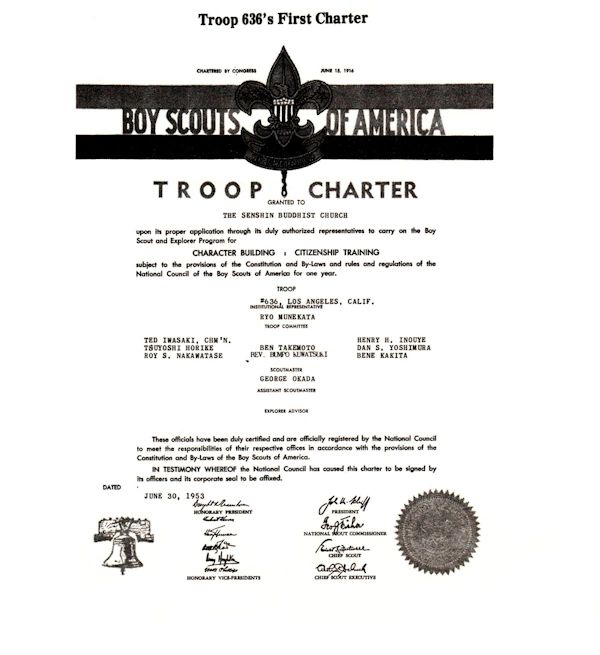 Scouting in our unit was started because a group of men at Senshin Buddist Church was interested in the boys of the southwest area of Los Angeles. It was in the fall of 1952 when the idea of starting a unit was mentioned. A group of seven men with Tsuyoshi Horike as its leader discussed the possibilities of organizing a scouting unit at the church. An official from the scouting office of the Mt. Vernon District of the Los Angeles Area Council came and discussed the procedures of scouting and planned the format of the program. In the spring of 1953 a charter was granted and given the unit number 636. The following men were instrumental in organizing the unit: Tsuyoshi Horike, Henry Inouye, Ted Iwasaki, Ryo Munekata, Ben Takemoto, Dan Yoshimura, and Rev. Bunpo Kuwatsuki.
Scouting in our unit was started because a group of men at Senshin Buddist Church was interested in the boys of the southwest area of Los Angeles. It was in the fall of 1952 when the idea of starting a unit was mentioned. A group of seven men with Tsuyoshi Horike as its leader discussed the possibilities of organizing a scouting unit at the church. An official from the scouting office of the Mt. Vernon District of the Los Angeles Area Council came and discussed the procedures of scouting and planned the format of the program. In the spring of 1953 a charter was granted and given the unit number 636. The following men were instrumental in organizing the unit: Tsuyoshi Horike, Henry Inouye, Ted Iwasaki, Ryo Munekata, Ben Takemoto, Dan Yoshimura, and Rev. Bunpo Kuwatsuki.
Organization
 Scouting in our unit was started because a group of men at Senshin Buddist Church was interested in the boys of the southwest area of Los Angeles. It was in the fall of 1952 when the idea of starting a unit was mentioned. A group of seven men with Tsuyoshi Horike as its leader discussed the possibilities of organizing a scouting unit at the church. An official from the scouting office of the Mt. Vernon District of the Los Angeles Area Council came and discussed the procedures of scouting and planned the format of the program. In the spring of 1953 a charter was granted and given the unit number 636. The following men were instrumental in organizing the unit: Tsuyoshi Horike, Henry Inouye, Ted Iwasaki, Ryo Munekata, Ben Takemoto, Dan Yoshimura, and Rev. Bunpo Kuwatsuki.
Scouting in our unit was started because a group of men at Senshin Buddist Church was interested in the boys of the southwest area of Los Angeles. It was in the fall of 1952 when the idea of starting a unit was mentioned. A group of seven men with Tsuyoshi Horike as its leader discussed the possibilities of organizing a scouting unit at the church. An official from the scouting office of the Mt. Vernon District of the Los Angeles Area Council came and discussed the procedures of scouting and planned the format of the program. In the spring of 1953 a charter was granted and given the unit number 636. The following men were instrumental in organizing the unit: Tsuyoshi Horike, Henry Inouye, Ted Iwasaki, Ryo Munekata, Ben Takemoto, Dan Yoshimura, and Rev. Bunpo Kuwatsuki.
Mrs. Ayako Horike became the first den mother with six boys. At the same time George Okada became the first scoutmaster of the troop. The unit grew and the need for parental help became essential. It became a necessity for every mother to become a den mother with few exceptions , and the fathers to serve in some capacity. The den mothers gave the boys many happy hours of togetherness, fellowship, and creative ideas.
Ever since the beginning the troop made great strides in providing the boys with the best possible program. It wasn’t easy as the program was new to the leaders but due to the unselfish efforts on the part of Scoutmasters George Okada, Sat Okamoto, Ben Ozeki, George Matsui, and Hiro Yamamisaka, the boys received valuable training in skills, character building, and the will to advance in ranks.
The Explorer program was combined in the beginning with the troop until the new Explorer program was introduced in 1959. Under the leadership of Masato Shimatsu the boys were able to step into the spirit of exploring, the will for adventure, and to search for new and better discoveries. Exploring also meant participating in discussions and activities of their chosen career with professionals. In 1961 advisor, Ken Uematsu made great strides in thrusting our young men into serving and participating in community projects.
In 1961 Ben Ozeki received the Council’s Silver Beaver Award. It was the first one for the unit. Ben was an example of ‘Mr. Scout Leader’ for he gave to our unit, the district and the council his energetic and dedicated service. Since then three others from the unit have also received the award: James Nakagawa (1966 ), Ted Koseki (1968), and Hiroshi Yamamisaka (1971).
During the first ten years we accomplished quite a record: 100% sustaining membership from 1954-1963; four boys served as chief of Makihiawip Chapter of the Order of Arrow; two boys served on the Lake Arrowhead staff ; sixteen boys and four adults went on the Silver Moccasin Hike of sixty-five miles; Good Turn Day ; annual window displays at Tamura Company which drew many compliments ; four of our adult leaders earned the Order of Merit including a Silver Beaver; and twenty-eight Eagle Scouts . During this time Kazuya Tsukamoto who was active in scouting in Japan came to our unit and joined in many activities, including the Silver Moccasin Hike. The unit earned many honors for participating in the spring and fall camporees.
During the ten years we registered at least 300 boys. The first den of six cubs and six scouts in the troop increased to six dens plus a Webelos den (fifty-five cubs), eight patrols (sixty scouts), and thirty-five explorers.
1963-1967
1963 found our country in unrest with the civil rights movement flaring here and there , the Far East erupting with political incidents, the Iraq premier assassinated, French Premier DeGualle’s attempted assassination, nuclear test ban failure, U.S. Atomic sub Thresher lost, political scandal in- England and Vietnam, and finally the assassination of our own President Kennedy.
The scouting movement was the one steadying thing in this world of strife and changes . We managed to absorb the social and political changes. Our unit of pack, troop, and post continued with their activities of preparing the boys to meet their responsibilities and to cope with their world .
Our unit was now ten years old. It swelled to its largest registration, boasting over 150 boys. In 1963 the pack was awarded the honor Pack of the Pueblo District. We were indeed a large group with many achievements and advancements.
This was the year when our unit celebrated its 10th anniversary on March 24 with a banquet at the Police Academy located in Elysian Park. This anniversary saw seven boys receiving their Eagle Scot rank. Ben and Mae Ozeki, constant boosters of scouting and of our unit, were recipients of special recognition for their outstanding service from the unit. To commemorate the anniversary a special white neckerchief with a Wheel of Dharma emblem was presented to all the boys in the troop and post.
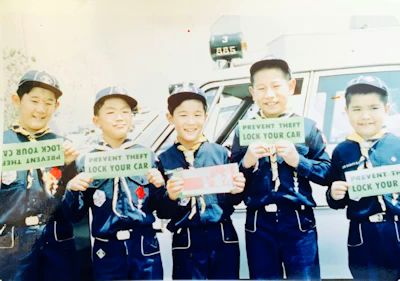 The annual events seemed to increase-the Blue and Gold Dinner, Pinewood Derby, Carnival participation, Nisei Week participation with the ” mikoshi,” Turkey Raffle, church picnic, beach parties, Basketball and Baseball Jamborees , Father and Son Steak Bake, Halloween parties, Good Turn Day, Sustaining Membership , classes, advancements, troop competition, cam pouts , and special events like fishing derby, kite flying, and Olympics. All this was possible because of the untiring efforts of our leaders and parents helping wherever they coµld.
The annual events seemed to increase-the Blue and Gold Dinner, Pinewood Derby, Carnival participation, Nisei Week participation with the ” mikoshi,” Turkey Raffle, church picnic, beach parties, Basketball and Baseball Jamborees , Father and Son Steak Bake, Halloween parties, Good Turn Day, Sustaining Membership , classes, advancements, troop competition, cam pouts , and special events like fishing derby, kite flying, and Olympics. All this was possible because of the untiring efforts of our leaders and parents helping wherever they coµld.
In 1966, the room behind the stage was now known as the Scout Room
In 1965 we found that we had to close Den 5. It also brought on a new Cubscout Handbook.
In 1966 we took over the room located behind the stage of the Social Hall and renovated it as our Scout room.
In 1967 we lost our first Scout leader, Kiyo Shiba. He was one of our assistant scoutmasters at the time of his death and the boys were plunged into the realities of life. In 1967 rules changed the Webelos entrance age to ten instead of ten and a half. Troop 636 participated in sending Care packages to Vietnam. Little did we know how many of our scouts would be involved in the service of their country.
1968-1972
With the large registration of boys, the scope of preparation and coordination became greater. However, with the strong support of the parent’s group all phases of the unit’s program became more meaningful and enjoyable.
During this period as in the previous years, there were many campouts and outings. The boys with their adult leaders went to such places as Lake Arrowhead, Camp Josepho, Vasquez Rock, Salton Sea, Camp Chilao, Emerald Bay (Catalina ) , Ladera Park, Lake Elsinore, San Clemente, Horse Flat, Camp Kern (Huntington Lake ), Death Valley, Camp Tulake ( Redland) , Mineral Wells, Pismo Beach, Pico Blanco ( Monterey), and Cherry Valley (Catalina). There were on the average seven campouts and outings each year.
Camporees at the district level were always fun for the boys and the adult leaders. In 1970 the first Oriental Camporee was held. It was held under a joint sponsorship of units consisting mostly of Asian boys in the Los Angeles Area Council. If was and has been seen through all these years a highly competitive camporee. Later the name was changed to Invitational Camporee.
lt was about this time when the leaders saw the activities of the post beginning to decrease. As the boys grew older and entered high school, their study program, school and outside activities began to take up much of their time.
Senshin Explorer Post 636 was disbanded in 1974
In 1971 and 1973 the post was not able to register with the Council. It was about this time, that we find the remaining older scouts staying within the troop with the formation of a senior patrol and becoming a member of the staff .
In 1972 Ernest Ogawa as advisor made an effort to revitalize the post with much concern. However, with much disappointment the post had to be discontinued by the end of 1974.
1973-1977
From 1973 there was a definite trend of less boys participating in both the pack and troop. Not to be outdone by the previous years with the large unit, the smaller group had a closer kinship and continued to maintain an excellent program of scouting.
It was in October of 1973 when our unit was transferred to the Hollywood-Wilshire District.
A review of this period shows many of the activities have been carried on annually as was in the previous years by the pack: the Blue and Gold Dinner at Rudi’s; Basketball Jamboree, Steak Bake at McManus Park which later became a picnic with hamburger barbeque because of the increasing cost of steak; Pinewood Derby which has always been the most exciting Pack Nite ; Church and Crenshaw Carnival with the Birthday Roll booth ; Swim Party at Roy’s Swim School; Beach Party at Marina Del Rey ; Mineral Wells invitation from the troop, the well planned and delicious dinner prepared by the boy scouts , and the comical and talented skits presented by the patrols and the cubbers ; Fishing Derby; Halloween Party with all the clever costumes; Christmas Party with Santa Claus who( ? ); Bon Odori; Observatory Outing; Paramedic demonstration; visitation to the Police Station; Dodger baseball games; Nisei Week; plane ride over Los Angeles; Good Turn Day; and Turkey and “Senbei” Sales jointly with the troop.
The cub scouts with their blue and gold colored ‘happi’ and ‘hachi-maki’ have become a permanent fixture as participants in the church’s annual Bon Odori.
The cub scouts with their blue and gold colored ‘happi’ and ‘hachi-maki’ have become a permanent fixture as participants in the church’s annual Bon Odori.
Halloween Pack Nite’s joint refreshment with the troop has always been a program of good fellowship. The wheel barrells have been serving well as portable barbeque for the hot dogs. Costume parade and selection of winners has always been one of the enjoyable highlights.
In April of 1974 the pack entered in the Hollywood-Wilshire District’s first Soap Box Derby at Montecito Park. Cubmaster George Tokeshi built the racer. Driver Kurt Tanezaki was injured when the racer flipped over. Jon Tokeshi, the alternate driver finished the race for the pack. The pack did not win but the cubs couts and the parents all had a great time with lots of refreshments prepared by the mothers.
The troop, like the pack continued with its annual activities, such as: Father and Son Bowling Tournament; Snow. Trips to Frazier Park, Palm Springs, and Mount Waterman; Las Vegas trips for parents and friends; Turkey and ” Senbei” Sales; Disneyland; Carwash; Swap Meet at Vermont Drive-In Theater ; swimming once a month in Gardena during the summer months; Memorial Day Flower Sale; Volleyball competition; Carnivals; Produce Sale at the church carnival; District Camporee; and Invitational Camporees.
Campouts were held at Circle X Ranch, Valcrest , Camp Cedar (Lake Arrowhead), Mineral Wells, Camp Emerson (ldyllwild) , Firestone, Tapia Park, White Sands, McGrath Park, El Dorado Park, Los Valley (San Diego County ), and Cherry Valley and Emerald Bay both in Catalina.
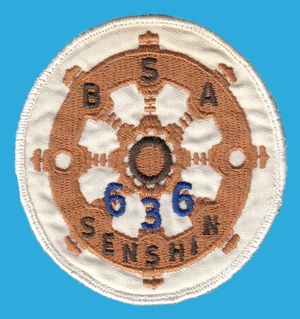 One of the memorable trips during this period was the Grand Canyon 3-day bus excursion over the Memorial Day weekend in May of 1973. Thirty-nine scouters and eight adults participated.
One of the memorable trips during this period was the Grand Canyon 3-day bus excursion over the Memorial Day weekend in May of 1973. Thirty-nine scouters and eight adults participated.
In August of the same year, our troop with Nishi Hongwanji and Pasadena Buddhist Church troops hosted the Seattle Buddhist Church troop, their Drum and Bugle Corp. and their All Girls Color Guards.
Other activities which should be mentioned are: Educational Civic Center Tour; Griffith Park Observatory; serving as traffic guides for the Los Angeles marathons; re-landscaping the Los Angeles Area Council Office garden; color guards at Gardener’s dinner and picnics; Paramedic from Station 34; and invitation to Anoma’s party.
In April of 1976 our troop participated in the Los Angeles Area Counc il’s Bicentennial Jamboree at Firestone with approximately 8,000 scouts participating from twelve districts for competitive events. Twenty-five scouts and four adult leaders from.our troop participated in this memorable Bicentennial event.
At the December 1976 Court of Honor, Barbara Tanezaki was honored with a scroll from the troop. The inscription read: “For her meritorious action in saving the life of a potential drowning victim…” We salute her for her heroic action.
In August of 1977 the troop hosted a contingent of Boy Scouts, Cub Scouts, and adult leaders from Matsuda City, Chiba, Japan.
With all these activities the boys have been meeting weekly with their adult leaders for troop and patrol meetings to gain more skill and to develop personal growth as defined in the scout program. Today, the troop has thirty-six boys who make up the staff, senior patrol, and the Falcon, Ha wks, and Sioux patrols. The pack has seventeen-boys in two dens and a Webelos den.
Currently, Court of Honors are held twice a year in June and December. It is the time when the boys are dressed in full uniform. The boys receive their awards and advancements with a sense of accomplishment. The parents observe with pride and satisfaction. The patrols receive their monthly awards and present their hilarious skits. There is an air of formality and fellowship.
There is plenty of food, for the parents make sure there is more than enough for the boys and the families. The mothers always do a wonderful job of coming up with the most delicious assortment of foods.
If there is an eagle candidate…the evening is topped with the Eagle Ceremony with all its dignity. It is a time of Joy, pride, satisfaction, reflection, aspiration, humility, and gratitude.
1978-1985
Troop 636 became infamous for their Yellow Jackets
Our unit has passed its twenty-fifth year. There were moments of joy, of pleasure, of anxiety, as well as of disappointment. Our unit and our membership has been able to balance all these events with the awareness of “On my honor I’ll do my best.” This is all a process of growing, a process of living. It has been a wonderful experience.
Our unit, our boys and our parents have received many distinguished awards, recognitions, achievements, and advancements. We an look ack and be proud. However, we show greater joy in knowing that the daily growth process, which all of us have Journeyed through the influence of scouting, has done so much to enrich our lives. We are most grateful for having had this opportunity to learn, to experience, and to share.
Many people with whom each of us have come in contact through scouting have enriched our lives. We have established lifetime friendships. We are most grateful to all of them. ·
There are those who no longer are with us who have done so much for our unit ang for all of us. We have not forgotten them. We are most grateful to all of them.
Today, our unit is much smaller than it was at its highest registration.
Still it has its warm fellowship, excellent adult leaders, strong parent groups, and most important a group of wonderful boys.
This process will continue, for our main concern is to serve and help the boys.
Our motto is “To serve, to inspire, and to share.”
Today, our unit is much smaller than it was at its highest registration.
Still it has its warm fellowship, excellent adult leaders, strong parent groups, and most important a group of wonderful boys.
This process will continue, for our main concern is to serve and help the boys.
Our motto is “To serve, to inspire, and to share.”
On January 6, 1985 a final Court of Honor was held by Troop 636 for eagle Scouts Glenn Minami and John Irie. They were the 114th and 115th eagle Scouts in the 31 year history of Senshin Boy Scouts. The final Troop had seven Scouts left and all seven attained the rank of an Eagle Scout. Mark Munekata went on to earn the Bronze Palm, Gold Palm and the Silver Palm.
The phenomenal high percentage of Eagle Scouts attainments in Troop 636 was attributed to Hollywood-Wilshire District Advancement Chairman Shun Ozono. He arranged for the Troop to attend Merit Badge Days at the Naval Reserve Center Encino, First Baptist Church-Los Angeles, Latter Day Saints-Cerritos and at various District Camporees.
Although he traveled by bus, Shun Ozono chaired the District Advancement Programs and served as Scoutmaster for Troop 636. On November 19, 1980 he was awarded the Award of Merit at the 32nd Annual Awards Dinner at the Patriotic Hall.
In the 1980s, the Troop continued its excellence established by Scoutmasters such as Asa Wakinaka in the 1970s. Asa Wakinaka was a remarkable 1eader; a rare combination of instructional skills, strength, kindness and leadership by example. In 1982 he chaired the Invitational Camporee, which was a scouting event involving eleven Boy Scout Troops from amongst the best in the Los Angeles Orange County areas. Both of his sons, David and Lester, became Eagle Scouts.
Troop 636 earned the loudest applause for their skits
No matter where Troop 636 went, they attained Honor Troop status, always first in earning merit badges, commended for their self-discipline and neatness, earned the loudest applause for their skits. They left their imprints of excellence at William Hart Park, Emerald Bay, Legg Lake, Ernest Debs Park, Camp Cedar, Whittier Narrows, Big Horn, White Sands, Tapia Park, Henninger Flats, Puddingstone Reservoir, Mineral Wells, Camp McGrath, El Dorado Park and Crystal Springs.
One successful summer camp in 1980 at Camp Cedar, 15 Scouts earned 43 merit badges and 9 partial badges. In the year 1982-1983, at the Invitational Camporee, the Troop won in successive years, the difficult and presti gious award plaque.for the Super Event. This event involved a skills course of firebuilding, map orientation, knot tying, lashing and first aid. It is a timed event and must be done correctly. Among the 10 troops participating, the Senshin Troop won first place two years in a row, winning over the perennial champion Koyasan Troop 379.
In August 1982, Scouts Mark Munekata, Ken Oyama, Keith Sawada and Eric Tanezaki went on the 8th Nippon National Camporee, covering Tokyo, Nikko, Sendai Mount Zao, Sapporo, Osaka, Kyoto, Nara, Nagoya and Yokohama.
The Troop, in appreciation to Senshin Buddhist Temple, helped at the Bullocks inventory, paper drives, Prajna collating, Obon set-up, funded copy machine, reconstructed patio benches, resurfaced social hall floor, painted and helped at Temple clean-up days.
The Senshin Cub Scout program ended in 1981, but the happy fun loving voices of the Scouts still echoes in the halls with appreciation to Ron Nakamura and Sumiko Ono. With the help of Ryo Munekata they helped formulate a smooth transition so that the remaining Cub Scouts were able to join the L.A. Betsuin Cub Scout program harmoniously.
Senshin Scouts went to the Air Force Academy , Yale University, etc. and became Superior Court Judges, Electronics Engineers, Musicians, and other successful endeavors
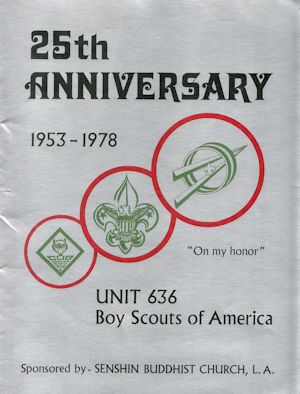
Portions of this history were lifted from the 25th Anniversary Booklet

